
Gracilariopsis andersonii
Sea Spaghetti
Fishboat Bay, Juan de Fuca Strait, B.C., Canada.
8 June 2020
Observations started at 10:50am PDT
Low Tide 0.0 feet at 10:41am PDT (measured at Sheringham Point Tidal Station)
Weather: Multi-layered overcast, bright light, light variable wind to 10km, calm sea, very low swell, temperature 14˚C, relative humidity 65%.
Phase of Moon: Waning Gibbous (Previous Phase, Full Moon, 5 June 2020 at 12:12pm PDT: Next Phase, Third Quarter, 12 June 2020 at 11:23pm PDT.)
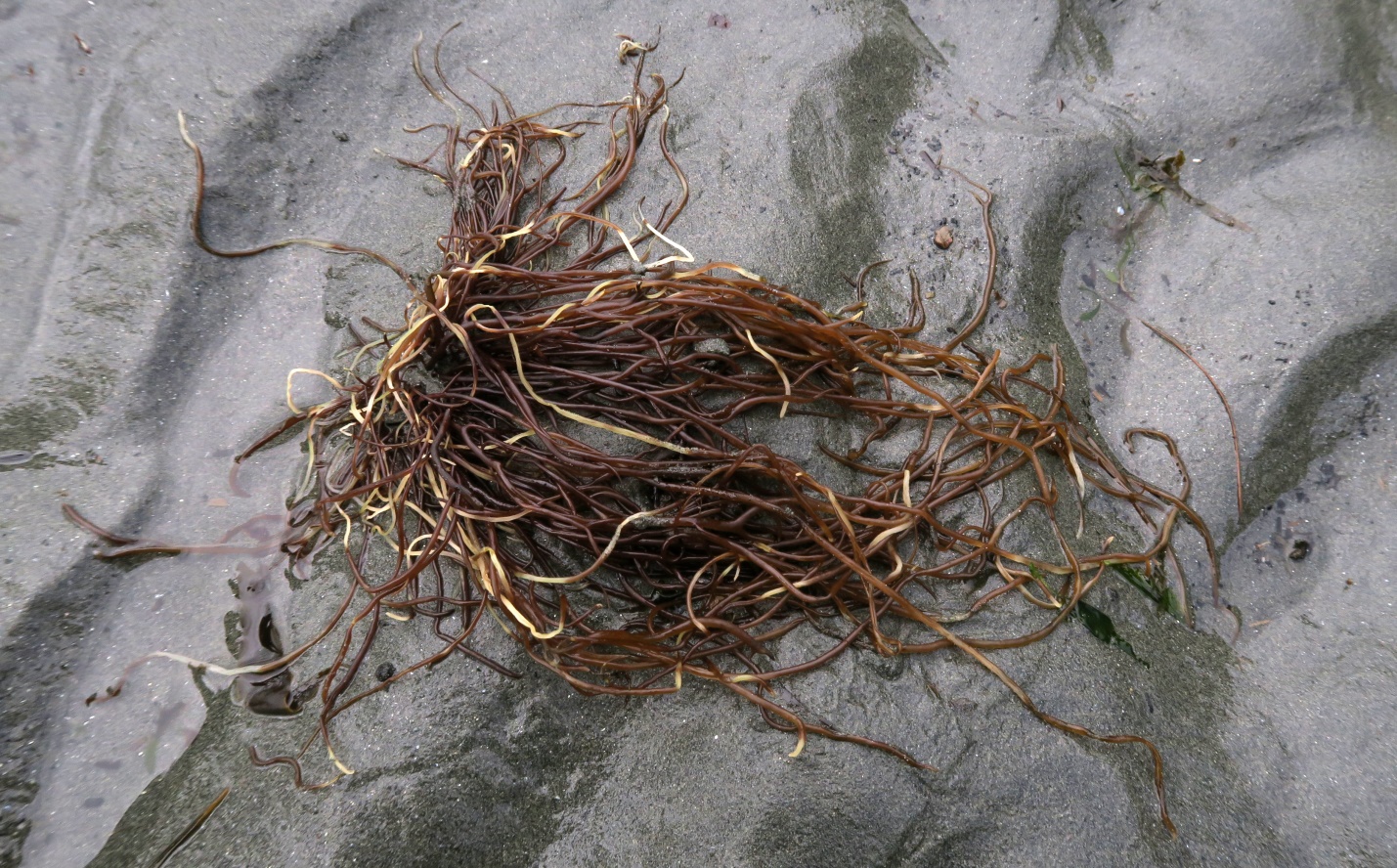
Figure 1: Gracilariopsis andersonii – a cluster of ‘spaghetti’ seems to be growing out of the sand. This red alga anchors itself to rocks cobble shells which in turn often become buried in sand. The cylindrical thalli of this seaweed extend through the sand growing up to 1.5 - 2 meters in length. Fishboat Bay, Juan de Fuca Strait, B.C., Canada. June 8, 2020. Photo ID 27469 ©Seaweedwhisperings.com
In situ observations:
Person 1:
Hair tossed back but not disheveled.
Smooth cylindrical stems.
Simple beauty.
Specimen is past prime, but still vibrant.
Spaghettini-like appearance.
Very smooth to touch.
Purple-y brown, bleached tips like dyed accent on a hairdo.
Somewhat stretchy.
Long hair covering baldness.
How does it hang on in the sand? A hidden anchor?
Could walk right by it if not for the accents.
I want to circle and look at it from all angles and at different distances.
Swish, like a horse’s mane.
Person 2:
Growing in area of cobbles buried in fine dark grey sand that is deep enough to be rippled like waves and to hold water in the troughs (of the sand waves).
A clump of light brown, irregularly but mostly unbranched tubes.
Tubes look solid.
Rubbery.
Older (?) thalli are bleached off-white in color.
Very shallow water area, mid to upper intertidal; don’t have to grow too tall to have some light.
Tugged on a thread and it broke – it IS solid, not a tube!
It stretches some, too – somewhat elastic solid cylinder of algae.
You’ve found a spot to grow where there’s not much competition.
You can tolerate the shifting sands?
You can tolerate the desiccation well, too?
You seem kind of lazy.
Do your solid blades float upwards – they have no air bladders. Or do you just hang out in the sand and then in the shallow surf, going where waves take you? In and out.
How are you anchored? Is it to a cobble down there beneath the sand?
50 or 60 stems seem to arise from one central anchor beneath the sand.
Your longest stems are about 18 to 20 cm long.
Newer stems are a darker, richer brown.
Age fades you from dark brown to medium brown to light brown to creamy off-white.
I dug deep in the sand to try to find the origin / anchor point of this individual. Discovered many other cylindrical ‘threads’ growing upward through the sand, but that as yet are totally below the surface.
Anchor / holdfast was deeper than I was prepared to dig, for fear of harming this individual.
Below the surface the threads are branched quite a bit more and they are the deepest brown color – a red burgundy brown.
Are you a red or a brown seaweed?
Sea Spaghetti indeed looks like a group of noodles lying on the beach. Not transparent but semi-translucent like cooked rice noodles dipped in soya sauce. You also have the “look” of a favorite pasta dish which involves cooking spaghetti slowly in olive oil, garlic and red wine – ‘pasta al vino rosso’.
Looks like a clown’s hairdo.
Unadorned; each thallus is very simple, almost a bit hastily formed looking, so not ‘perfect’ in any dimension, but close to it.
No leaves (foliose parts), few branches, not dressy or flashy.
Plain, almost ordinary, except that where you grow you stand out as distinctive in your simplicity.
Your color is even kind of drab.
You really go for the plain and the simple.
Face the world as you are.
Looks sort of improbable, or partly done, left-off, unfinished.
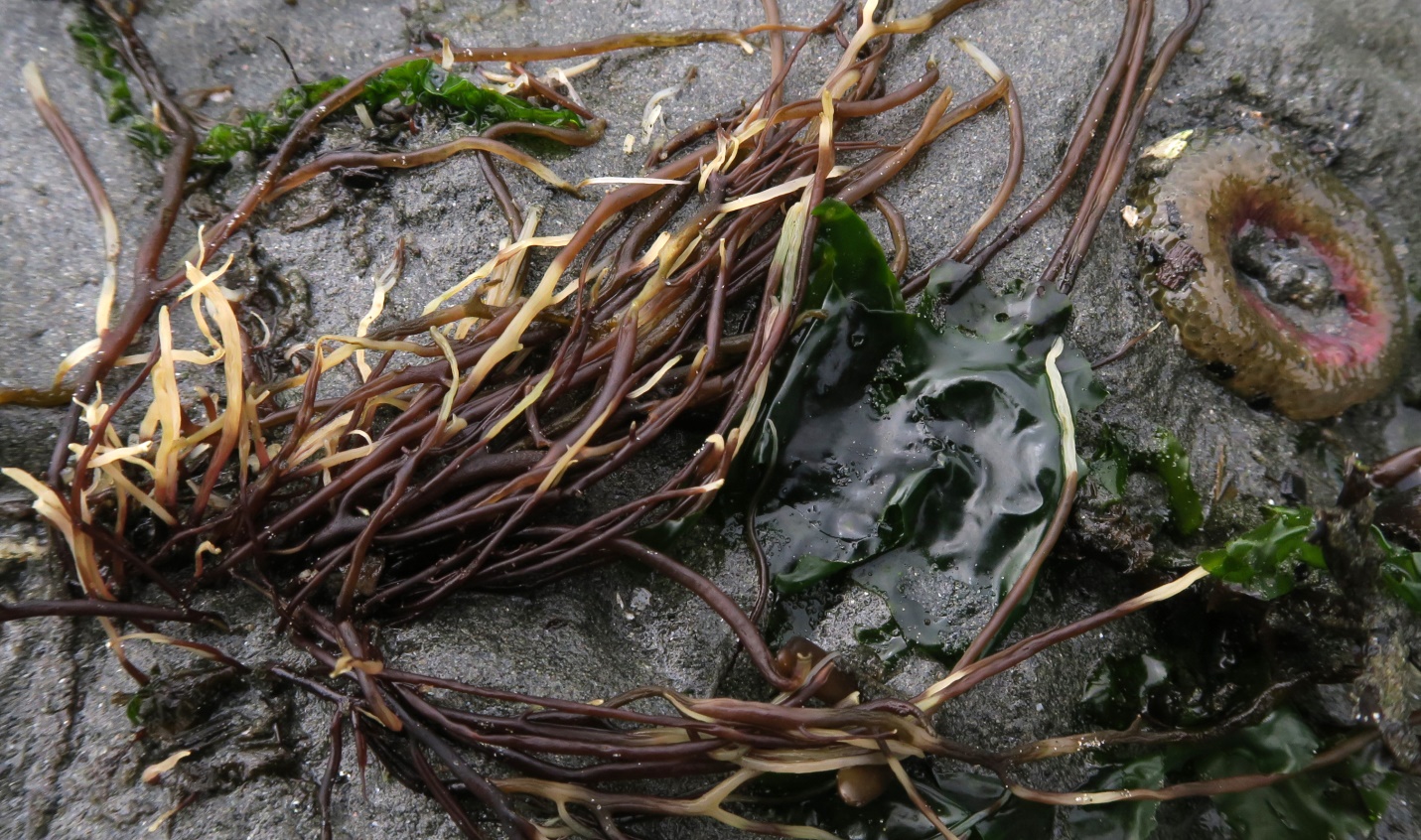
Figure 2: The Sea Spaghetti here is partially its healthy deep red brown color and partially its aged and bleached color. Such discoloration normally happens later in the annual growing season. Fishboat Bay, Juan de Fuca Strait, B.C., Canada. June 8, 2020. Photo ID 27470 ©Seaweedwhisperings.com
Further Observations & Impressions:
Person 1:
Loose locks tossed back.
Stems twist together when pulled from water.
Splays out beautifully when dunked in water.
Smooth but wiry feel.
Very smooth but tickles face – I’m surprised.
Nice crunch.
Unfamiliar flavor, perhaps beef.
Pleasant taste.
“Gracilariopsis” – graceful and bouncy.
“Andersonii” – just a name (of a person).
“Spaghetti” – limp on a plate.
Person 2:
Even though you are exceedingly simple of form, you have some ‘backbone’ to you when the tide is out. You lay down but you have a look that you are not broken – just bending with the reality of gravity acting on you.
Crude. Yes, you look a bit crude.
Refinement is not there, or at least not evident on the exterior.
But you do catch attention – what is that quality…? Brazenness, yes, that fits you Sea Spaghetti.
Bold and without shame..., obvious confidence – brazen.
Living as suits you and no concerns for how others do it, or for what others think.
Rubbing along a moist stem feels slightly raspy – not smooth or slippery; it is slightly porous.
Thallus has some elasticity when tugged, then breaks.
Crisp and succulent to chew.
Flavor is a bit distinctive – like an Apiaceae. Somewhat of a saltwater aftertaste.
Leaves my mouth and tongue feeling slightly tingly and a bit ‘cleansed’ as if by a fine scouring brush.
No smell.
Sea Spaghetti – very apt name; and I did really like eating it, although this ‘spaghetti’ is crunchier than the cooked noodle from Italy!
“Gracilariopsis” – a very pleasing name to speak; all full of rich vowels. The overall impression is one of beauty and poise, of “grace” while ‘viewing’ or being ‘viewed’ from another vantage point. This is my own invented definition of the name. As “iopsis” to me sounds like things turned upside down or inside out or some such perspective-challenging occurrence. Does the sand washed habitat and simple form of this alga make this a common reality of life for Sea Spaghetti – does it therefore naturally become a master of having poise no matter the situation? I think this is so – quite the attribute in an unfinished, partly done, sometimes crude-looking seaweed.
“Andersonii” – just makes me wonder who Anderson was…, why was he remembered / honored by having his name given to this seaweed?
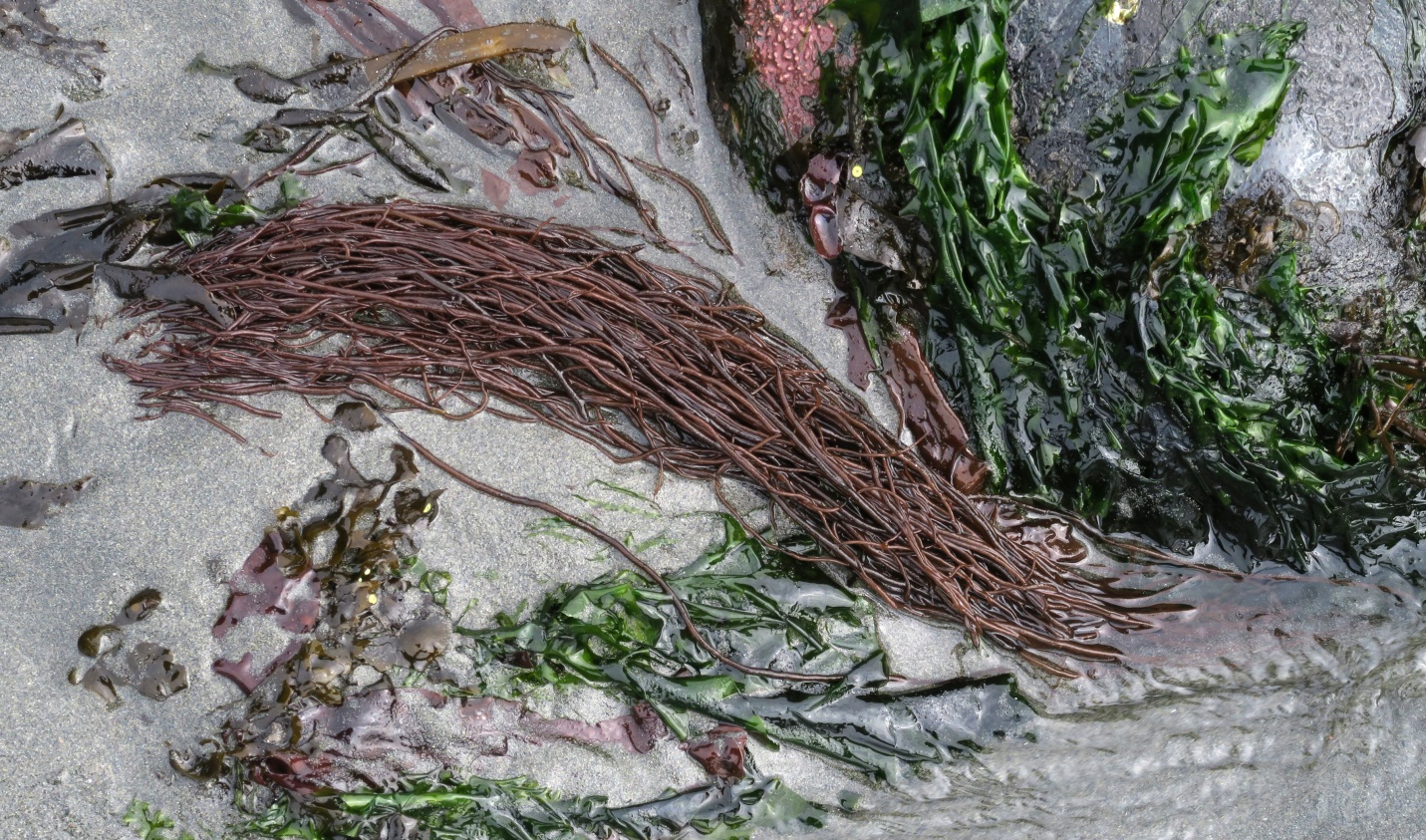
Figure 3: This large cluster of Gracilariopsis andersonii thalli was found almost a month after the day when we did our Whispering. It is interesting to note that there is no bleaching damage here; possibly this individual was safely buried under sand and thus avoided the damaging influence we observed with so many other individuals four weeks earlier. These thalli are also much longer, 80 or 90 cm in length. Fishboat Bay, Juan de Fuca Strait, B.C., Canada. July 6, 2020. Photo ID 27471 ©Seaweedwhisperings.com
Listening Further:
Person 1:
Not happy, not unhappy.
Perhaps just existing.
Hanging on when past prime.
Fades early?
Anchored – strong values.
Flimsy branches – no need to express values.
Smooth stems – nothing for others to grasp. Others don’t understand you and that is no concern to you.
Person 2:
The energy of this seaweed is like “taking it easy”.
Enjoy how you are, where you are.
They can be almost surprised that there might be something to do, to work towards. As for them the regular state is simply “I’m here; I’m good; I’m actually really quite good”.
But…, there’s a touch of boredom, of missing being challenged of seeking a bit more stimulation – so, occasionally they will throw out an effort here or there (grow a branch).
I’m not too sensitive to touch, weather, sun, wind, but do not “tug” me, says Gracilariopsis. This is where I belong and I will not move. I will break before I’ll move.
Stubborn – yes, a bit.
Flexible, yes, but only so far.
But do NOT pull or tug me.
Sand moving around my branches nudges me slightly but it doesn’t really influence me.
I know who I am.
I know what I like.
I am not really open to influence.
There’s quite a bit to me that is not seen; it’s below ground, below the surface. What is visible is not ALL there is to me.
Am I private or shy? Not really.
I’m confident.
I have no need for you to see all of me.
But I do like it when I’m noticed with favor – appreciated.
But I don’t even really need the appreciation of others; just don’t try to criticize me. You’d be a fool to try because there’s nothing to criticize – I am very fine as I am and I know it!

Figure 4: A look at another ‘cluster’ of Gracilariopsis andersonii; the holdfast and first sections of the thalli are all buried in sand. Fishboat Bay, Juan de Fuca Strait, B.C., Canada. June 8, 2020. Photo ID 27472 ©Seaweedwhisperings.com
Discussion:
Indifference. Indifferent to the opinions of others.
No need to explain yourself to anybody.
Strong footing, confident, anchored in one’s values, no need to justify one’s self.
So, in a way you end up isolated. And thus you can’t grow because you’re almost too anchored in your values.
Not open to discussion.
Feel there’s nothing to learn, nothing else is needed, nothing needs to change.
Your experience is full.
Connection with others can be quite shallow. If interacting socially, there’s often not much depth.
Others experience you as unapproachable.
Or others avoid you because you don’t engage and or seem to listen.
Events, circumstances, interactions may appear as if they should influence you, but you, like rubber, return to your form – you’re stuck in your way of being and you’re QUITE fine! There’s no doubt about it.
Even though ‘rubbery’ there is a lack of flexibility. Everything is rigid.
Rigidity brings the isolation and inability to absorb new possibilities – Gracilariopsis will break rather than change.
And the flip side of this confidence that can appear to be quite rigid is the “gracil” – ar – “iopsis” definition we perceived – that this energy has a remarkable ability to retain grace, poise, balance and equilibrium under all kinds of challenging or stressful situations. Perhaps the rigidity and superficial social presence is one of the external costs or ‘appearances’ while the ‘internal’ is actually very dynamically engaged.
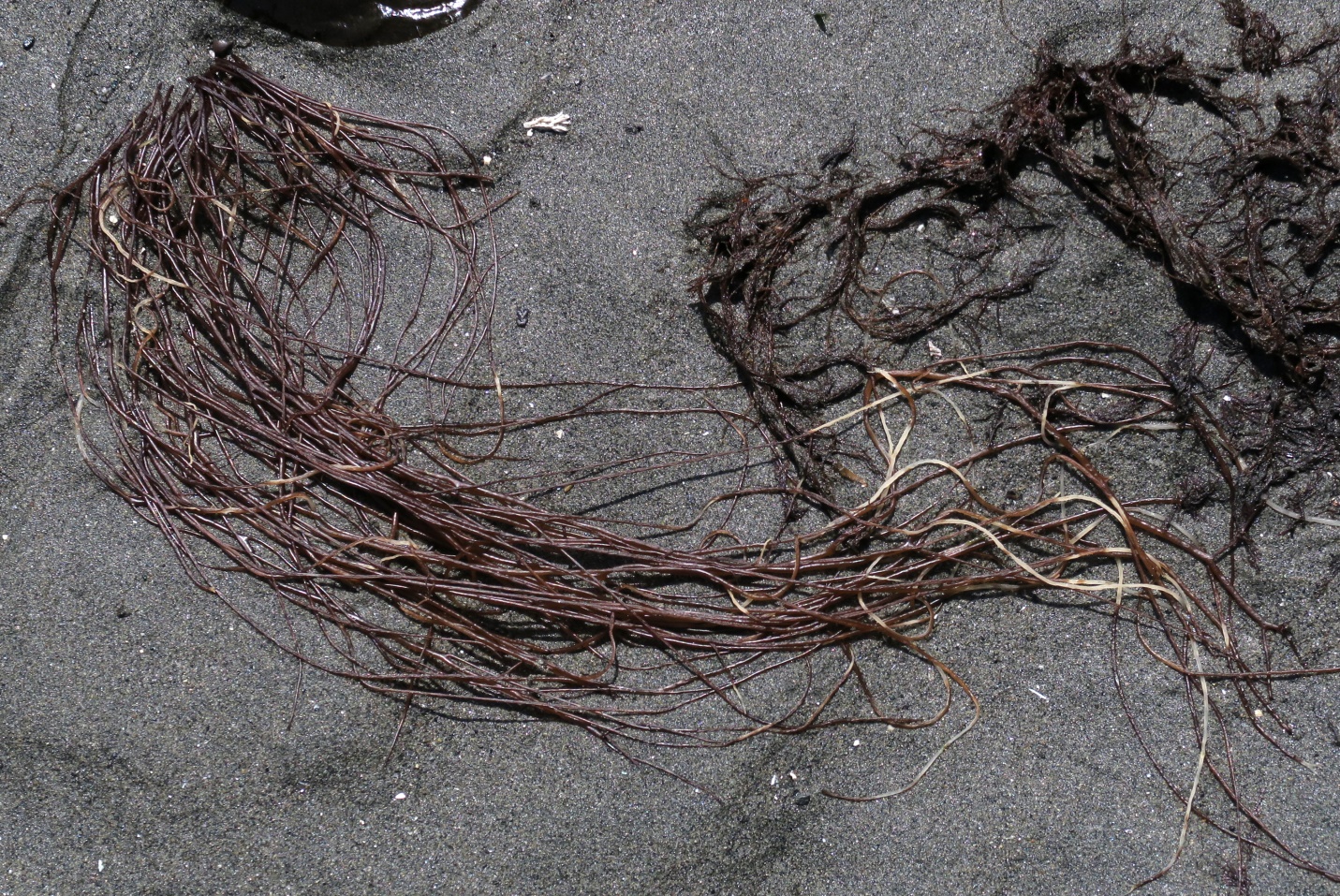
Figure 5: Fresh seaside spaghetti anyone? This red alga is actually a popular ‘sea vegetable’ in some regions of the world. The long thalli here were over a meter long and have suffered some kind of damage that has caused sections to bleach from deep brown to off white. Fishboat Bay, Juan de Fuca Strait, B.C., Canada. May 10, 2020. Photo ID 27473 ©Seaweedwhisperings.com
Biology & Natural History Information
Description:
Sea Spaghetti is anchored by a small, discoidal holdfast from which extend several branches that can grow up to 2 meters tall. The branches are a reddish brown to reddish purple early in the season, often fading to yellowish brown later. Stems are cylindrical, sparingly branched, with slender, cartilaginous, flexible axes up to almost 2 mm in diameter. There is variability in the diameter of the axes. The stems are rather cartilaginous in texture – this has suggested the rather whimsical common name. Carposporophytes (reproductive structures) form small bumps (to 1.8 mm in diameter) along the branches.
Habitat:
This red seaweed species grows on rocks of the mid intertidal to shallow subtidal zones (to 18 meters), at sites that are somewhat exposed to wave action. Sea Spaghetti will anchor to rock, cobble or sometimes shells that are often partially buried in sand.
Pacific Coast Distribution:
Southeastern Alaska to Gulf of California, Mexico; Japan.
Remarks:
Sea Spaghetti can continue to grow after it is torn from its anchor and while drifting freely in the water. It has been suggested that this may be an important dispersal mechanism for the species. This species is edible and desirable; it is a colorful and nutritious ingredient added to salads. Graciliaria species are a very popular ‘sea vegetable’ in Japan where it is known as “ogo” and in Hawaii where it is called “limu loa”. The word, “gracil” means thin or slender in Latin. “Iopsis” is from the Greek meaning: resembling, like, or appearance of.
Classification:
Phylum: Rhodophyta
Class: Florideophyceae
Order: Gracilariales
Family: Gracilariaceae
Genus: Gracilariopsis
Species: Gracilariopsis andersonii (Grunow) E.Y. Dawson 1949
Former name(s): Cordylecladia andersonii Grunow 1886; Gracilaria andersonii (Grunow) Kylin 1941; Gracilara sjoestedtii Kylin 1930: Gracilariopsis sjoestedtii (Kylin) E.Y.Dawson 1949.
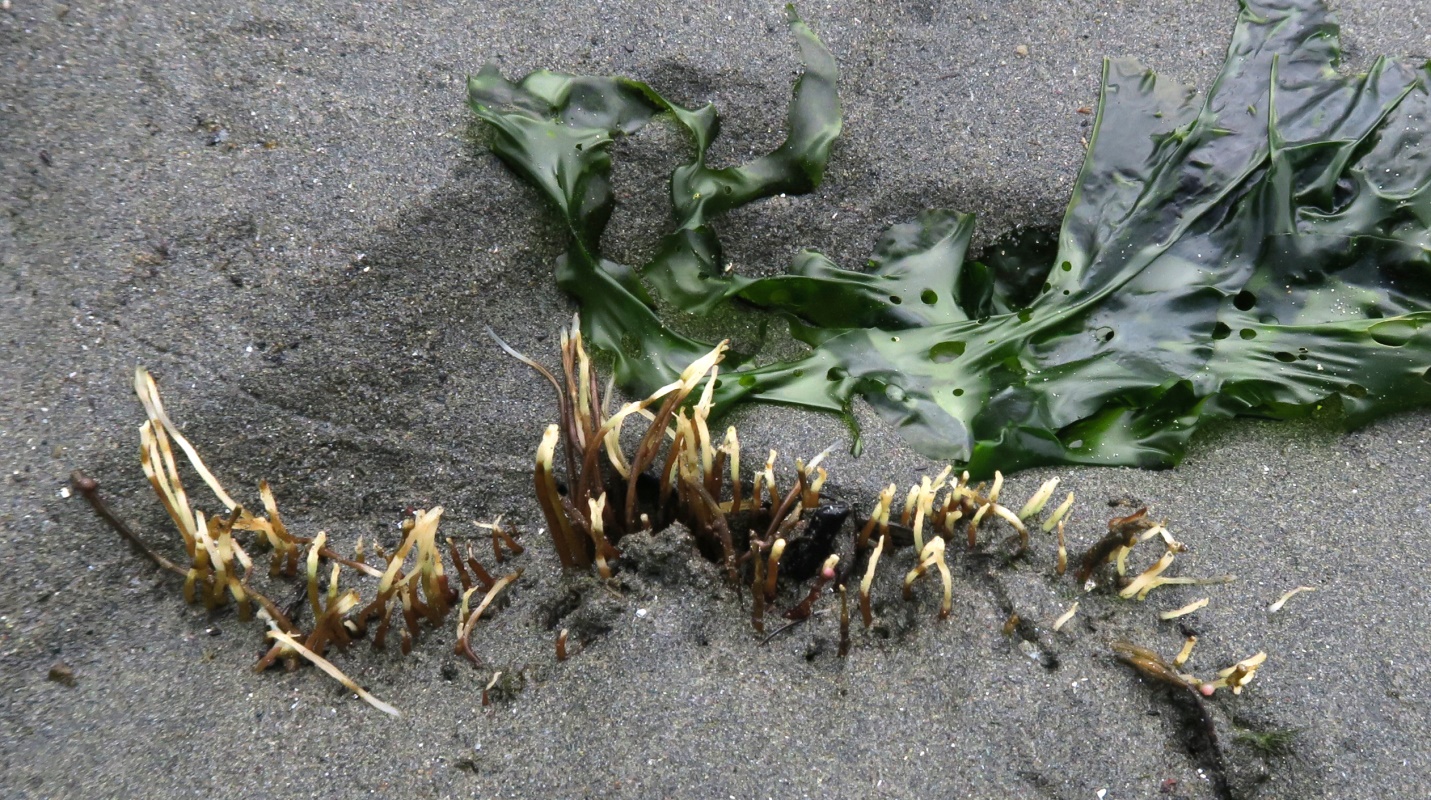
Figure 6: Gracilariopsis andersonii, multiple thalli here are all bleached and have subsequently broken off. The somewhat desiccated green alga lying next to it is Ulva lactuca. Fishboat Bay, Juan de Fuca Strait, B.C. Canada. June 8, 2020. Photo ID 27474 ©Seaweedwhisperings.com
![]()